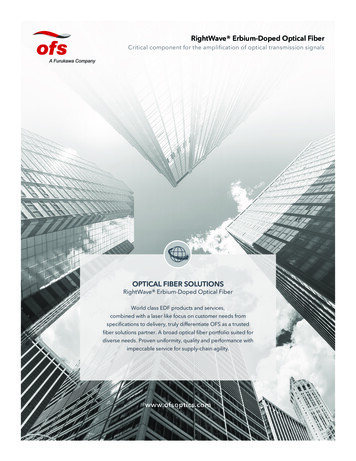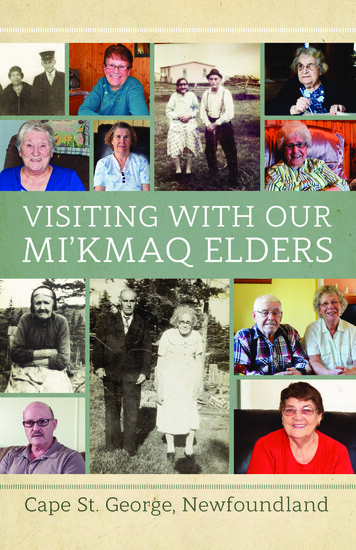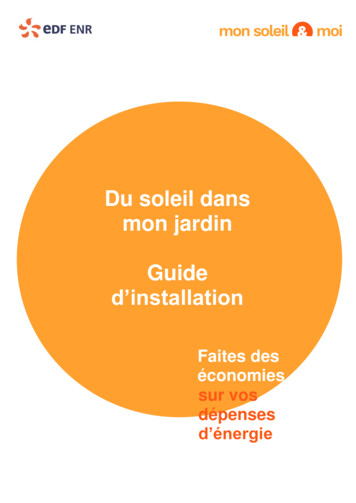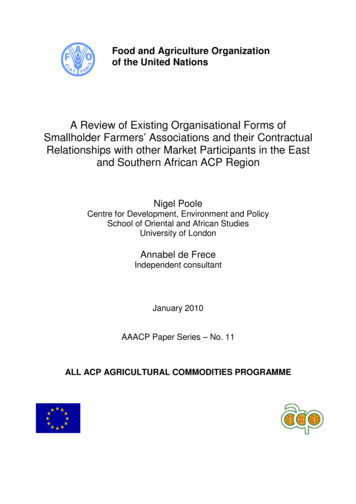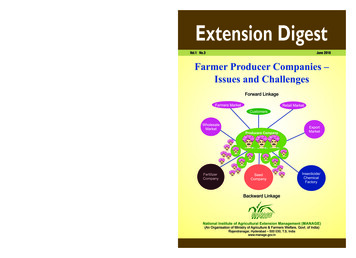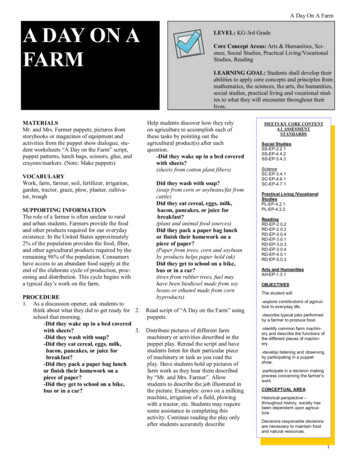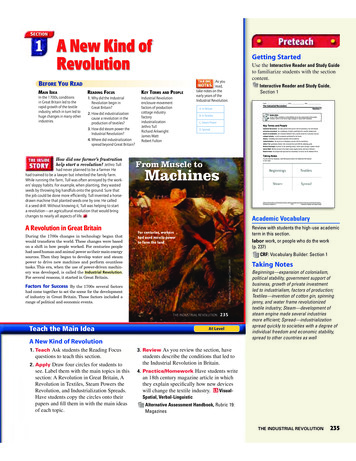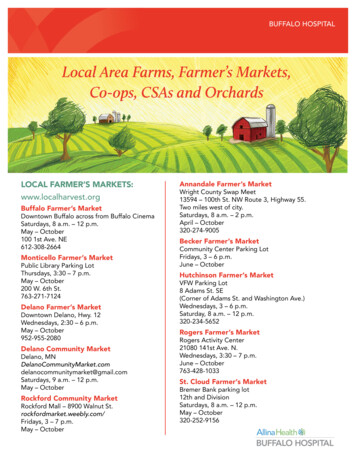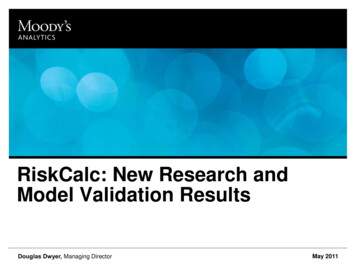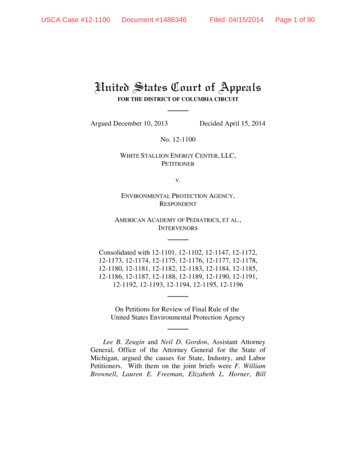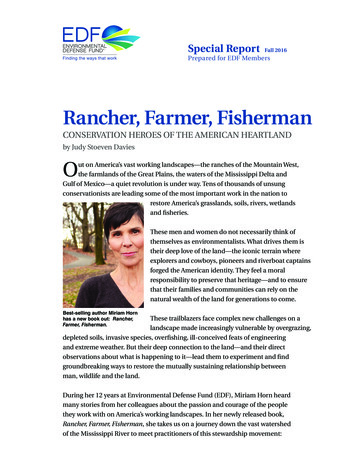
Transcription
Special ReportFall 2016Prepared for EDF MembersRancher, Farmer, FishermanCONSERVATION HEROES OF THE AMERICAN HEARTLANDby Judy Stoeven DaviesOut on America’s vast working landscapes—the ranches of the Mountain West,the farmlands of the Great Plains, the waters of the Mississippi Delta andGulf of Mexico—a quiet revolution is under way. Tens of thousands of unsungconservationists are leading some of the most important work in the nation torestore America’s grasslands, soils, rivers, wetlandsand fisheries.These men and women do not necessarily think ofthem selves as environmentalists. What drives them istheir deep love of the land—the iconic terrain whereexplorers and cowboys, pioneers and riverboat captainsforged the American identity. They feel a moralresponsibility to preserve that heritage—and to ensurethat their families and communities can rely on thenatural wealth of the land for generations to come.Best-selling author Miriam Hornhas a new book out: Rancher,Farmer, Fisherman.These trailblazers face complex new challenges on alandscape made increasingly vulnerable by overgrazing,depleted soils, invasive species, overfishing, ill-conceived feats of engineeringand extreme weather. But their deep connection to the land—and their directobservations about what is happening to it—lead them to experiment and findgroundbreaking ways to restore the mutually sustaining relationship betweenman, wildlife and the land.During her 12 years at Environmental Defense Fund (EDF), Miriam Horn heardmany stories from her colleagues about the passion and courage of the peoplethey work with on America’s working landscapes. In her newly released book,Rancher, Farmer, Fisherman, she takes us on a journey down the vast watershedof the Mississippi River to meet practitioners of this stewardship movement:
a Montana rancher, a Kansas farmer, a Mississippi river man, a Louisiana shrimperand a Gulf fisherman.A Discovery Channel documentary based on the book will air in summer 2017.Miriam, you spent three years traveling the Mississippi andwriting this book. What’s it about?It’s about conservation heroes of the American heartland who defy almost everymodern stereotype of what a conservationist is. They are deeply traditional andthey harvest natural resources at commercial scale. What their stories reveal isthe shallowness of the stereotype. Conservation has been a core American valuesince our founding, tied to values these heroes remain committed to, like selfsufficiency, faith, responsibility to family, community, heritage. Many of themhave deep roots in the landscape, where their families have lived for generations.They understand fully how interdependent we all are with the rest of nature—andMississippi River WatershedChoteau1HelenaBismarckBillingsSt. Paul isonChicagoDes rado alinaJeffersonCityLouisvilleSt. LouisWichitaSanta FeTulsaAmarilloOklahomaCityNashvilleFort SmithMemphis3Little Rock1Dusty Crary’s Cattle Ranch2The Knopf Family Farm3Merritt Lane’s Canal Barge Company4Wayne Werner’s Fishing Grounds5Sandy Nguyen’s Shrimping CommunityShreveportJacksonBaton RougeNew Orleans542LeevilleVeniceFrankfort
are doing some of the most consequential work in the nation to protect the ecosystemsthey live within.These men and women are humble before nature’s genius, majesty and power.They see the damage done by our efforts to dominate nature. Nature can doso many things we can’t do, often more cheaply and effectively and with muchgreater flexibility.None of these heroes is paralyzed by fear. They just get out there and step up to dothe work. And they’re not outliers: I went to an agricultural conference in a packedgigantic auditorium in central Kansas. Fifteen hundred farmers from all over theMidwest, straight out of a John Deere commercial—baseball cap, overalls andweathered faces. They were asking heartfelt questions about how to farm in waysthat protect soil ecology, increase biodiversity and hold carbon and nitrogen, whilemaking their land more resilient to climate change. Seeing their willingness to lookto new ways to farm made me really hopeful. It blew me away.What do their stories tell us about America?I wrote this book to challenge several pervasive and powerful myths about theheartland. First, that in these traditional, deep-red states, “real Americans”—theones who run tractors and barges and fishing boats, who go to church and town hallmeetings—are hostile to environmental values. And that producing food at “industrialscale” is inherently destructive to nature.I also wanted to refute the myth that America is irretrievably broken, trapped inever‑more-hostile warring political camps. Western ranchers are often the staunchestdefenders of federal land protections for grizzlies and wolves. Big Midwest commoditycrop growers can be our most sustainable farmers. Commercial fishermen are the besthope we have for protecting fisheries and coastal ecosystems.All of these people not only believe in American democracy but are making it work,talking openly and civilly with people very different from themselves to find the bestways to move forward together. Underneath it all is a deep strain of patriotism, whatRonald Reagan called the conservative obligation to conserve “our patrimony.” Thesefamilies are the caretakers of the landscapes that define our national identity: Themountain majesties, fruited plains and shining seas.They also have that strong sense of community that was part of the settling of theWest. All expressed a powerful sense that you need to go help your neighbors whenthey need you. And they also understand that the choices they make have an impacton the watershed and the nation—even the world.3
That’s what’s out there in the heartland. But you wouldn’t know it by listening to CapitolHill and the media.Tell us about your journey down the Mississippi.The Mississippi is the third-largest river on the planet (behind only the Amazonand the Congo). I started in the Northern Rockies on the banks of the Teton River,a tributary of the Missouri which flows into the Mississippi, where I got to knowa Montana cowboy named Dusty Crary.Dusty runs several hundred head of cattle on several thousand acres with his mom,wife and three kids. The Crary land is part of 10 million acres of public lands and vastprivate ranches left largely untouched. It still has all the animals that were there whenLewis and Clark came through: wolves, grizzlies, wolverines, mountain lions and lynx.When I went out with Dusty in the spring to watch calves being born, eagles swoopeddown to grab the placenta.What is Dusty doing to conserve that area?Magnificent ranches like Dusty’s are threatened by development. Every year, many areconverted to cropland, split into ranchettes, or torn up by oil and gas drilling. But theseprivate lands, which typically sit on fertile river bottoms, are vital to wildlife. Elk, deerand pronghorn depend on them for food and shelter in the winter and to have theirbabies in spring. This part of Montana is the only place in America outside of AlaskaRancher Dusty Crary’s frontier forebears were part of the Wild West. They bootlegged and trapped coyotesto get by.4
where grizzlies still come down out of the mountains onto the prairie. And many ofthe ranches sit next to protected public lands—providing vital connectivity acrosslarge landscapes so animals can roam to find food, water and mates.Dusty loves living alongside those animals and feels a moral responsibility to protecttheir home. He’s also committed to honoring a heritage that reaches back fourgenerations—a heritage he hopes his kids will carry on. After seeing the sprawlthat had overtaken places like Denver, he put the family ranch into a “conservationeasement,” meaning he sold the development rights to a land trust so it could neverbe broken up. He faced outright animosity from some neighbors, who accused himof being in bed with environmentalists—and of selling off his kids’ birthright. But healso won many of them over, and helped get several hundred thousand additionalacres of private ranchland into permanent protection.Dusty then set to work protecting the rugged public wildlands he looks up at fromhis ranch, and where he has spent half his life hunting and packing with mules. Dayafter day, for the better part of a decade, he spent hours around kitchen tables with animprobable band of longtime enemies—cattlemen, fishermen, federal land managers,outfitters, hikers, hunters and environmentalists—trying to figure out how to preservethe 400,000 acres of U.S. Forest Service land that sits between the now-protectedprivate ranches and the Bob Marshall Wilderness.He and his neighbors drafted a piece of federal legislation that would allow familiesto continue the work they’ve always done on the land, but block new uses that wouldalter its historic character. Dusty made several trips to Washington, D.C., and testifiedbefore Congress. Finally all the years of listening and building support paid off. In 2014,Congress passed the Rocky Mountain Front Heritage Act.Next, you traveled down the watershed to the prairie. What didyou find there?Out on the Great Plains, America’s grain belt, I met Justin Knopf, a Kansas farmer whois a creationist Christian and deeply believes in taking care of God’s garden. He farms4,500 acres of wheat, soy, sorghum and alfalfa with his father and brother on land hismother’s family homesteaded right after the Civil War.I went out with him on a combine for two days one June to harvest winter wheat.When they’re harvest ing, they can’t stop. It’s one of the many times during the yearthat they’re completely vulnerable to natural forces. Three minutes of hail can wipeout an entire year’s work. So we rode together from 6 am to 2 am. I was amazed by thetechnology he uses. Streams of real-time data come over his combine’s computer, andmore over his smart phone, telling him the soil type at every depth; what he’s done to5
each square foot of the field for the last 10 or 15 years; the nutrients the crop needs;ambient temperature and weather forecasts.I also saw how attentively he watches every second as he moves through the field. Heclimbs down often to dig into the soil and touch and smell the wheat. His intimacy withthe soil and crops—the watching and level of attention—his wife likens it to the care hegave their babies.Does all that scientific information give him an edge hisancestors didn’t have?Drought and deep plowing were primary causes of the 1930s Dust Bowl thatforced tens of thousands of families to abandon their farms. While studying atKansas State University, Justin came to understand that the way his family hadbeen farming for generations had left their soils depleted of both organic matterand biodiversity. A teaspoon of soil contains thousands of species of microbes—trillions of organisms—which hold the soil together, hold carbon in place, delivernutrients to crops and keep the soil permeable to water. If those microbes are kepthealthy, and the soil isn’t ripped up by a plow, it can catch and hold the scant rainthat falls on the Plains.Justin persuaded his family that they needed to farm in a way that mimics the prairie:giving up tillage and re-introducing biodiversity, through crop rotations and plantingcover crops.Farmer Justin Knopf constantly looks to science and new farming methods to improve his land. He believeshe is part of a continuum—and that his children will be better farmers than he is.6
Rancher, Farmer, FishermanBy Miriam HornW.W. Norton & Co.Chapter 2: FarmerBy eight, the men are back at work, long shadowsnow falling across the amber fields, the sky turninglavender, a pheasant flushing as dusk falls. In alldirections a gently swelling ocean of farmlandstretches to the horizon, broken only by the hulk of300-foot concrete grain elevators, “the giants of theplains.” Looking across this bountiful vastness, it isnot hard to understand why America’s anthems allsing of these landscapes, so overwhelming in their beauty and promise. Andwhy everyone who can has come to help with harvest: Lindsey’s parents fromKansas City, Grady’s dad and little sister to ride along in the cab of the grainwagon as he ferries his golden cargo. And why Justin, who’s been running farmequipment since he was eight years old, can’t imagine any place he’d rather be.“I appreciate the long day, the ability to see the sun rise and set, the opportunityto observe Creation. When I can’t see the horizon, I feel closed in. The prairie iscomforting to me.”What does that involve?Justin never plows his fields. He cuts the wheat very high up the stalk and leaves thosestalks and other residues in place to cool the soil and protect it from pounding rainsand the powerfully erosive winds that created the black clouds of the Dust Bowl. Thoseresidues shelter birds and other wildlife—and restore the soil to health.Does that make his crops more resilient?Yes. He’s increased his yields even in the face of increasingly intense heat, unseasonalblizzards and unprecedented dry periods followed by deluges.And he continually experiments, working with Kansas State and advanced soil labs,which measure the progress he’s making to restore organic matter and microbialdiversity to the soil.All the conservation heroes in my book have that in common: they are committed tocontinually learning more and doing better.7
How is Justin protecting the Mississippi watershed?There isn’t a perfect way to farm. Everything has trade-offs. Most organic farmers, forinstance, avoid using weed-killing chemicals by plowing, but that comes with its owncost: damage to the soil structure and microbial ecology. Justin takes very seriouslyweighing all those trade-offs—thinking in the biggest way possible.He rotates crops and plants cover crops to discourage pests and weeds—and when hedoes use chemicals, he uses data from his fields to apply only as much fertilizer as isneeded, so it is not lost into the atmosphere (nitrous oxide is an incredibly powerfulgreenhouse gas) or waterways, where it creates algae blooms, which smother sea lifein the Gulf of Mexico.Justin understands that what he does on his farm affects water quality downstreamand therefore the fishermen in the Gulf. He thinks about that all the time. That’s oneThe Mighty Mississippi RiverBeginning in the mid-19th century, the U.S. Army Corps of Engineers began to buildever-higher levees along the Mississippi River to prevent periodic flooding in theheartland. Those barriers secured cities and navigation but at great cost: severingthe tie between the life-giving river and the Delta it had spent thousands of yearsbuilding. Starved of river sediments, 2000 square miles of Louisiana’s wetlandsdisappeared, jeopardizing the wildlife and birds they support and the most productivefisheries in the world—and, at the same time, endangering critical oil and gasinfrastructure and the coastal cities the wetlands once buffered from storm surges.In the 1970s, EDF attorney Jim Tripp helped launch an effort to save the coastline andwetlands. After Hurricane Katrina devastated New Orleans in 2005, that effortcoalesced into the most ambitious environmental restoration project in history.Louisiana’s Coastal Master Plan won support from everyone from oil and gascompanies and former Republican Governor Bobby Jindal to EDF and other leadingenvironmental NGOs. It is designed to rebuild wetlands by releasing the riverthrough controlled “diversions” to again nourish its estuaries with fertile sediments.In 2010, when the BP oil disaster dealt the coast and fisheries another unprecedentedblow, EDF worked to get bipartisan support for the RESTORE Act, which willchannel 8 billion in BP fines to fund that coastal restoration. EDF also launchedChanging Course, a design competition that brought engineers and plannersfrom around the world to think even longer term about how to maximize theriver’s natural power to build land while keeping these critical ports, industriesand communities thriving.8
of the reasons working my way down the Mississippi watershed was so appealing.It brought home the fact that every decision these heroes make has long-lasting andfar-reaching implications.You ended your journey in the Gulf of Mexico, with acommercial fisherman. Why is he one of your heroes?Wayne Werner had seen the worst of what bad regulations can do. He watchedfish populations and dock prices plummet—and urged his sons to find a differentlivelihood. But he also stepped up to change the system, spending 30 years tanglingwith fisheries regulators to bring back the red snapper and keep his and his buddies’small businesses afloat. He was one of the first fishermen to join EDF in our effort toThe River ManMerritt Lane runs one of the world’spremier shipping companies, foundedby his grandfather in the depths of theDepression and now grown to more thana thousand vessels. The New Orleans–based company moves barges carryingchemicals and fossil fuels up and downthe Mississippi and its tributaries, andoil rigs into the Gulf and through thePanama Canal.Hurricane Katrina brought home toMerritt the vulnerability of his businessand his community to intensifying stormsand sea-level rise. Recognizing the need for natural buffers, he has becomean important champion of coastal restoration in Louisiana. He representsthe navigation industry on the leadership team that developed and continuesto refine the Louisiana Master Plan to restore the coast without disruptingeconomic activity. He was also elected to represent his peers in Washington.Merritt joined the coastal planning effort reluctantly, having often been frustratedin his dealings with environmentalists. He told Miriam, “The issue I often have withthe environ mentalist conversation is that it doesn’t complete the sentence. It’s just‘Stop doing this.’ OK . . . and then what? If you shut us down, either the stuff doesn’tmove and you cripple the economy, or you shift it onto trucks, which are far worsefor the environment.”9
implement “catch shares,” a market-based strategy to sustainably manage fish bygiving fishermen a long-term financial stake in the fishery’s recovery.EDF has worked with most of your heroes. What do their storiestell you about the way we work?Wayne is a great example. With a lot of misinformation circulating about catch shares,Wayne had been dead set against them. But then he was invited to speak at a con ference at Tulane University. After his speech, he was approached by two people fromEDF—marine biologist Pam Baker and economist Pete Emerson—who said “Look,we know you’re opposed to thiscatch share idea. But it’s reallyworked for fishermen elsewhere.And we’d like the chance tounderstand what worries youand see if there are ways toaddress those concerns.”They listened carefully, under standing that a seasoned fisher man knew a lot more about theday-to-day experience on thewater than they did. He toldthem he was worried that richguys or big companies wouldcome in and buy up all the fishingshares—and drive little guyslike him out of business.Pam and Pete helped him anda few other fishermen see thatthey could use their extensiveknowledge to help write the rules,designing into the catch shareWayne Werner was once lost at sea with his crew duringthings like limits on how manya storm, forced to go out in dangerous weather to catch asshares any one business couldmany fish as possible during a brief commercial fishingseason. With catch shares, he now fishes safely andown—or requirements that thesustainably all year long.shareholder be on the water atleast half the year. Eventually, Wayne and his buddies began speaking out at FisheryCouncil meetings and traveling with EDF to Capitol Hill. In 2007, they finally won acatch share management plan for red snapper. And in the decade since, both fish andfishermen have enjoyed a remark able rebound.10
ShrimperSandy Nguyen came to the Louisiana bayou after fleeing Vietnam with her familyin the 1970s. Her father had fished in the Mekong Delta, the mouth of anotherof the world’s great rivers. She now fights to rescue the estuaries that harbor theshrimp, oysters and crabsher community relies on.Most are refugees fromthe wars in Vietnam andCambodia. Having survivedperilous journeys in tiny boatsacross the South China Sea,they have been flattened,over and over again inLouisiana, by hurricanes, theongoing loss of the landbeneath their fishing villagesand the BP spill. They nowfear the changes that the Coastal Restoration Plan will bring. Sandy is theirchampion, making sure their voices are heard. She told Miriam, “If you seriouslytalk with people, both to those who want to help and those who need the help,we’re all humans; there’s got to be ways to figure it out.”What do all these heroes have in common?All are courageous and passionate, with a strong work ethic and strong family tiesacross generations. They’re willing to stand up for change, sometimes at great personalrisk—with their family’s livelihood on the line. But they have no dogma or party line.Each choice is deeply considered, based on their own generations of experience andeverything they can learn from others. And they’re constantly learning, rethinking theirpositions, remaining open to any question or challenge to their thinking. They don’thave a trace of sanctimony, which may be what I love best about them. They’re respectful,always, of what other people bring and their different ways of seeing the world.You co-authored Earth the Sequel with EDF presidentFred Krupp about the race to reinvent energy. This is avery different kind of book. What made you decide to write it?Since I was a little girl, I’ve spent lots of time on a family farm owned by dear friends inthe Central Valley in California. Like Justin, my adopted farm family farms close to11
5,000 acres—land passed down through several generations. And like Justin, they aredeeply concerned with stewardship of the land. I fell in love with them and withfarming—the hands-on challenges and problem solving—and the amazing conversationsaround their dinner table.In my 20s, I worked for the Forest Service in Colorado on a landscape very much likethe one where Dusty lives and works. I saw that ranchers and foresters brought anintimate knowledge and deep love and respect for the landscape. I learned about thecomplexities of timber management and that chainsaws aren’t always bad.Those experiences deepened my respect for people who actually live and work on thisland, and have for generations. They have more at stake, a more seasoned love for it,than anybody.You and your daughter go to the cabin you built in Coloradoevery summer. What do you hope she gets from that experience?She’s a New York City kid and sometimes we struggle because I want her to be outsideenjoying nature more. Dusty says it best—we’re part of all of it: the sky and wind andforest and wild animals. This is our habitat. We cannot lose sight of that. If our kids, ontheir electronic devices, becomeso disconnected that they can’tpossibly feel love for nature, willthey take care of it?Traveling for this book remindedme of our amazing good fortuneas Americans, given such a varied,beautiful, bountiful country.Everyone in this book voices deepgratitude for that gift—a strongspiritual connection to the land scapes we celebrate in our nationalanthems, which they work everyday to nurture and protect. Ihope others will be inspired tofollow in their footsteps.Author Miriam Horn with her daughter Francesca Sabel near theContinental Divide and the headwaters of the Colorado River.For more information, please contact EDF member services at 800-684-3322 or email members@edf.org.12Environmental Defense FundT 212 505 2100New York, NY / Austin, TX / Bentonville, AR / Boston, MA / Boulder, CO /257 Park Avenue SouthF 212 505 2375Raleigh, NC / Sacramento, CA / San Francisco, CA / Washington, DC /New York, NY 10010edf.orgBeijing, China / La Paz, Mexico / London, UKPrinted on recycled paper (30% post-consumer)
they harvest natural resources at commercial scale. What their stories reveal is the shallowness of the stereotype. Conservation has been a core American value since our founding, tied to values these heroes remain committed to, like self-sufficiency, faith, re
